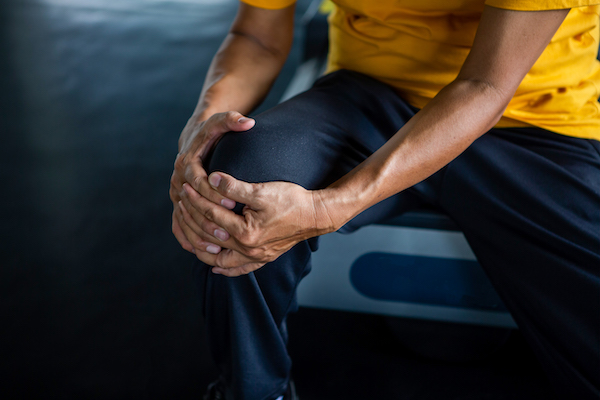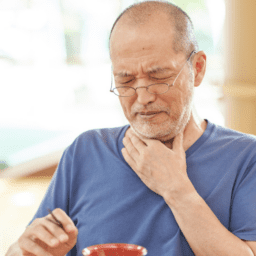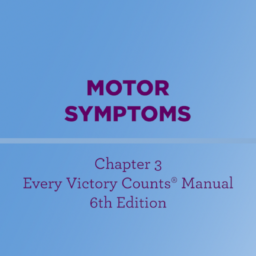Does your low back feel tight after gardening? Is your shoulder sore because of the boxing class you took yesterday? Is the stiffness you feel due to arthritis? Or is all of this discomfort just a part of getting old?
Maybe, but it’s also possible that these symptoms are due to rigidity.
What is rigidity?
Rigidity is one of the most common motor symptoms in Parkinson’s, and 90% of people with Parkinson’s experience rigidity at some point during their Parkinson’s progression.
Rigidity is when your muscles feel stiff and tighten involuntarily. It can occur in your arms, legs, neck, back, and even smaller facial muscles. Some people experience it more on one side of their body, but others experience it in both. This stiffness can decrease your range of motion and cause pain and achiness in your joints and muscles.
For some people, the initial motor symptom of Parkinson’s is tightness in one limb. Stiffness in the shoulder when putting on a coat could be due to a golf game yesterday or impingement of the shoulder joint, which is an orthopedic problem. However, it could also be a pre-motor symptom of Parkinson’s, which can start years before your diagnosis of Parkinson’s.
Though tremor is the most well-known, visible, and recognized motor symptom of Parkinson’s, rigidity is another primary motor symptoms used to diagnose Parkinson’s. The other two are slowness of movement (bradykinesia) and postural instability. Since bradykinesia impacts rigidity, it’s important to consider both when diagnosing and treating. And because rigidity can be painful and uncomfortable, be sure to discuss your symptoms with your doctor. Treatment and medication that offer relief for rigidity are available.
Motion is lotion.” – Marty Acevedo, Davis Phinney Ambassador
What impact can rigidity have on my life?
Stiffness and pain can impact your life in a variety of ways.
Balance
Rigidity can decrease the ability of your arm to swing while walking. This mechanical issue can cause difficulties with stability, which can increase your risk of falling.
Being misunderstood
Rigidity in your facial muscles can cause facial masking, which friends and family may misinterpret as a lack of interest.
Falling asleep
Muscle stiffness in the evening can cause challenges turning over in bed and getting a good night’s rest.
Fatigue
Because your muscles are working continuously, you may feel tired.
Pain
Not only will your muscles feel tight, but by being under constant tension, you may feel considerable pain.
Buttoning a shirt
Rigidity can affect small movements required for precision tasks like getting dressed, writing a note, and other activities of daily living (ADLs).
Curved spine
If you have rigidity in your back, it can cause a stooped posture. This position can be painful and also increase your risk of falls.
What are the different types of rigidity?
Rigidity is characterized by an increase in muscle tone. It affects both the muscles used to flex and extend your joints. The two types of rigidity observed in Parkinson’s are lead pipe and cogwheel. Their names describe how each one affects movement.
Lead pipe rigidity (sustained)
In lead pipe rigidity, your limbs feel like they’re stuck in one position. It’s sustained, like a lead pipe. In this instance, you feel constant resistance throughout the whole range of motion.
Cogwheel rigidity (intermittent)
In cogwheel rigidity, your limbs move with small jerky movements. It’s intermittent and ratchet-like. You might feel a click or catch in your muscle as you move your arm in a circular motion. Though cogwheel rigidity is found in other forms of Parkinsonism, it’s most common in Parkinson’s.
How will my doctor test for rigidity?
At your appointment, your doctor will ask you to keep your limbs as relaxed and loose as possible. Then, they will gently flex and extend your joint, such as your elbow, wrist, or shoulder. If you’re experiencing rigidity, your doctor will feel an increased resistance to movement in both directions – extension and flexion. A unique aspect of cogwheel rigidity is that the jerky motion occurs at both slow and fast speeds.
How can I manage symptoms of rigidity?
A variety of treatments exist to help you manage rigidity. Here are a few you can try today.
Exercise
If your muscles are tight and painful, you may not want to move. However, this lack of movement will cause even more stiffness. It’s a negative feedback loop. Create a daily routine, so you exercise even if you don’t feel like it.
Not all exercise has to be high-intensity. Whether it’s cleaning out a closet, hiking, walking to the mailbox, practicing yoga, dancing, bicycling, or watering your plants, frequently moving throughout the day can help decrease rigidity.
Yoga
Not only can yoga help with flexibility and mobility, but it can also decrease depression and increase the feeling of well-being.
Click here and scroll to the bottom for six yoga movements of the spine you can do while sitting on a chair.
Warm water bath with Epsom salt
A soothing, warm water bath can relax muscles and decrease rigidity.
Physical therapy, occupational therapy, speech therapy
Regularly participating in these rehab therapies can help decrease rigidity in specific parts of your body. Speech therapy can help prevent facial masking.
Medication
You don’t have to live with stiffness and pain. Talk to your doctor about your rigidity and if nothing else is working, ask about medications that can help.
Mix it up
Participate in a variety of activities to decrease stiffness. On different days, try yoga, dancing, tennis, swimming, bicycling, walking the dog, Rock Steady Boxing… the list goes on.
Use a health tracking app
Make a movement goal on a weekly basis. Get social with it if that’s something that increases the likelihood you’ll stick with it. Receiving kudos and positive feedback from friends can motivate you even more.
Buddy system
Find a friend to walk or exercise with consistently. Talking while walking gives you something to look forward to.
Exercise while learning
We live in the golden age of audio offerings. Listen to an audiobook or podcast while you walk around the block or in the woods. Learn about cooking, gardening, fishing, life stories, and specialty hobbies. If you’re looking forward to a chapter from an audiobook, exercising isn’t a chore. You can find vast libraries of audiobooks on Audible or the Overdrive app, which gives you access to free audiobooks from your library.
How can I increase movement throughout the day?
Too often people think they need to attend a class at a gym for it to count as movement. That’s not true. Whether it’s mopping the floor, gardening, or vacuuming, it’s all activity. A recent study found that participating in these non-exercise physical activities was the best predictor of the UPDRS motor scores (Unified Parkinson’s Disease Rating Scale). One key to managing rigidity is to move often throughout the day.
Wake up and stretch
Start the day with five minutes of stretching to decrease stiffness and pain. Stretching in bed or the shower are easy places to start the day out on the right foot.
Have a phone moment
Walk or stand when you’re on the phone.
Stretch when folding laundry
After folding each item, reach to the sky. It’s amazing how much stretching you can accomplish after folding five pieces of laundry.
Be more vigorous when doing activities of daily living
Whether you’re washing dishes, sweeping, or making the bed, do it with a little bit more vigor. Put the laundry basket at the bottom of the stairs and carry each item up separately to increase the steps you take during the day.
Make commercial breaks movement breaks
If you’re watching TV, stand up and march while you swing your arms during the commercials. To increase your muscular strength, lift soup cans or a do a few downward dogs.
Moving more every day is easier said than done. Remember, even small changes can make a big difference. Pat yourself on the back for all of the movement activities you do each day. Every victory counts!
Cool down
To prevent your muscles from becoming stiff again, remember to cool down and stretch properly. Don’t just exercise and then stop. Stretching not only prevents injury, but it also decreases stiffness the next day. Reach towards the ground to stretch those muscles in the back of your legs. Reach towards the ceiling to stretch your upper body.
Rigidity and the pain associated with it are often not reported because people think it’s just part of getting older, but you don’t have to suffer. There are treatments for rigidity that can improve your quality of life. Talk with your doctor and come up with a plan that works for you. By increasing your daily movement, exercising, and talking to your doctor about medications, you can live better with rigidity and Parkinson’s today.
Further Learning
Therapeutic effects of yoga in people with Parkinson’s
Impact of a weekly dance class on people with Parkinson’s
Parkinson’s and Rigidity: Scroll to the bottom for short videos on how to reduce rigidity
Want More Practical Articles Like This?
Much more can be found in our Every Victory Counts® manual. It’s packed with up-to-date information about everything Parkinson’s, plus an expanded worksheets and resources section to help you put what you’ve learned into action. Request your copy of the Every Victory Counts manual by clicking the button below.
Thank you to our 2020 Peak Partners, Amneal and Kyowa Kirin, with special support from Adamas, for helping us make printing, distributing, and shipping the Every Victory Counts manual for free possible.









Thank you so much–this article came to me at the perfect time! I’ve had terrible leg cramps at night for the last week without a clue why, and I’m sure it’s because I’ve gotten gradually less and less active as Covid-19 has lasted longer and longer. I know what to do now. so thanks again.
Great explanation, easy to understand and practical advice that can be readily incorporated into everyday life. Thank you